Poole’s Cavern
Useful Information

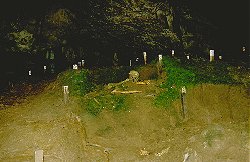

| Location: |
Green Lane, Buxton, Derbyshire, SK17 9DH.
From manchester A6 to Buxton, from Newcastle-Under-Lyme to Leek then Buxton. Signposted. (53.250231, -1.926656) |
| Open: |
Easter to OCT daily 9:30-17. NOV to Easter daily 10-16. Last tour 1 h before closing. [2023] |
| Fee: |
Adults GBP 17, Children (5-16) GBP 7.50, Children (0-4) free, Seniors GBP 15, Students GBP 13, Family ticket (2+2) GBP 42. [2023] |
| Classification: |
 Karst Cave Karst Cave
 river cave. river cave.
|
| Light: |
 Incandescent Incandescent
|
| Dimension: | T=7 °C |
| Guided tours: |
D=45 min, L=600 m, St=28. V=390,000/a [2000] |
| Photography: | photography allowed, no video |
| Accessibility: | 100 m suitable for wheelchairs |
| Bibliography: |
Trevor D. Ford, David G. Allsop (1984):
Student’s Guide to Poole’s Cavern,
Buxton Country Park, 1984.
|
| Address: |
Poole’s Cavern, Green Lane, Buxton, Derbyshire, SK17 9DH, Tel: +44-1298-26978.
|
| As far as we know this information was accurate when it was published (see years in brackets), but may have changed since then. Please check rates and details directly with the companies in question if you need more recent info. |
|
History
| 1580 | first mentioned in the book Sidera by Sir Philip Sidney (*1554-✝1586), nephew of the Earl of Shrewsbury. |
| 1622 | described by Michael Drayton in his Poly-olbion. |
| 1854 | to protect the cave and its speleothem the 6th Duke of Devonshire appointed Frank Redfern as custodian-cum-guide. |
| 1954 | cave sold to Mrs J Alcock. |
| 1857 | gas lighting installed. |
| 1965 | closed due to the death of Mr Alcock. |
| 1976 | electric lighting installed and cave reopened. |
Description
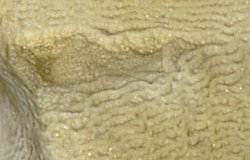
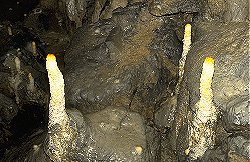
The name Poole’s Cavern comes from The robber Poole, who is reputed to have lived in the cave in the 15th century.
The cavern is part of the Wye system, the Wye is a subterranean river which enters the cave at the end of the guided tour from a boulder choke. The whole tour path follows the banks of this river.
The huge entrance was easy to find and so the cave has been used by man since Neolithic times. Several archaeological digs have revealed Stone Age tools and artefacts, Bronze Age pottery and a wealth of Roman material.
The hill above the cave is called Grin Low and it is a fine viewpoint. On top stands Solomon’s Temple, a folly built in 1895 by public subscription. This whole area is pock-marked with lime works and lime kilns, in which the stone was heated to change it to lime. To remove this eyesore the 6th Duke of Devonshire planted it with trees in the early 19th century, which has now led to a mature wood of beech, ash and elm.
Right above the cave once a large limestone quarry existed. This quarry was closed and in the 1980s bought by the city council of Buxton. In order to use it as a campground, limestone sand and lime - a remains of the quarry - was used to fill in the craters to level the floor. Nobody imagined, that because of its enormous surface, this limestone sand is very easy to solute. So the water in the cave is very high in calcite and the flowstones below the former quarry grow five times as fast elsewhere! The formations have been coloured by minerals leached out of the lime-tips on the hillside above. These include manganese (blue-grey) and iron (orange). A rather strange formation is called Poached Egg, as a rather flat white stalagmite has a round, yellow bulb in the middle formed from the lime remains. The result actually looks like a fried egg.
- See also
 History of Poole’s Cavern by Tony Oldham (2002).
History of Poole’s Cavern by Tony Oldham (2002). A tour thro’ the whole island of Great Britain, divided into circuits or journies by Daniel Defoe (2002), Letter 8, Part 2: The Peak District.
A tour thro’ the whole island of Great Britain, divided into circuits or journies by Daniel Defoe (2002), Letter 8, Part 2: The Peak District. Search DuckDuckGo for "Poole’s Cavern"
Search DuckDuckGo for "Poole’s Cavern" Google Earth Placemark
Google Earth Placemark Poole’s Cavern - Wikipedia (visited: 24-SEP-2010)
Poole’s Cavern - Wikipedia (visited: 24-SEP-2010) Poole’s Cavern, official website.
Poole’s Cavern, official website.
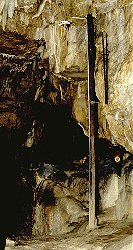
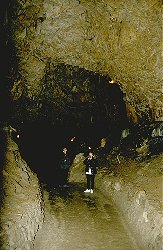
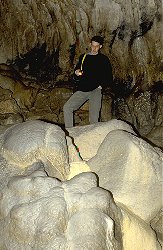
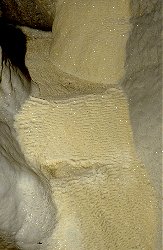
 Index
Index Topics
Topics Hierarchical
Hierarchical Countries
Countries Maps
Maps